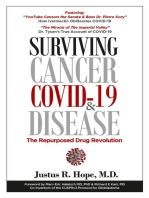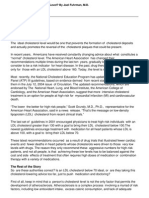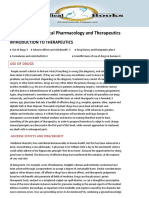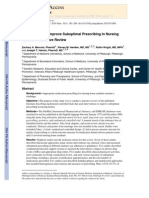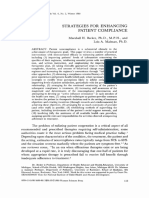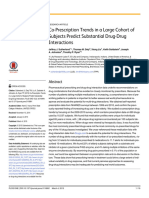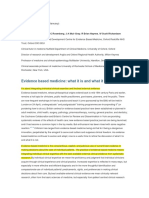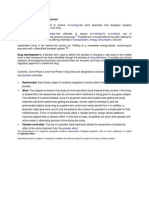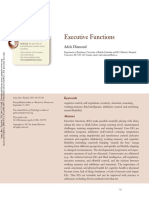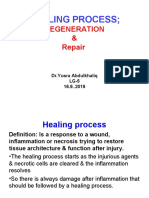Adherence To Medication. N Engl J Med: New England Journal of Medicine September 2005
Adherence To Medication. N Engl J Med: New England Journal of Medicine September 2005
Uploaded by
Fernanda GilCopyright:
Available Formats
Adherence To Medication. N Engl J Med: New England Journal of Medicine September 2005
Adherence To Medication. N Engl J Med: New England Journal of Medicine September 2005
Uploaded by
Fernanda GilOriginal Title
Copyright
Available Formats
Share this document
Did you find this document useful?
Is this content inappropriate?
Copyright:
Available Formats
Adherence To Medication. N Engl J Med: New England Journal of Medicine September 2005
Adherence To Medication. N Engl J Med: New England Journal of Medicine September 2005
Uploaded by
Fernanda GilCopyright:
Available Formats
See discussions, stats, and author profiles for this publication at: https://www.researchgate.
net/publication/7681391
Adherence to medication. N Engl J Med
Article in New England Journal of Medicine · September 2005
DOI: 10.1056/NEJMra050100 · Source: PubMed
CITATIONS READS
7,397 8,054
2 authors:
Lars Osterberg Terrence Blaschke
Stanford University Stanford University
30 PUBLICATIONS 8,314 CITATIONS 299 PUBLICATIONS 18,493 CITATIONS
SEE PROFILE SEE PROFILE
Some of the authors of this publication are also working on these related projects:
Adherence interventions in TB therapy in LMIC View project
All content following this page was uploaded by Terrence Blaschke on 24 January 2018.
The user has requested enhancement of the downloaded file.
The new england journal of medicine
review article
drug therapy
Adherence to Medication
Lars Osterberg, M.D., and Terrence Blaschke, M.D.
Drugs don’t work in patients who don’t take them.
— C. Everett Koop, M.D.
a dherence to (or compliance with) a medication regimen is
generally defined as the extent to which patients take medications as pre-
scribed by their health care providers. The word “adherence” is preferred by
many health care providers, because “compliance” suggests that the patient is passively
following the doctor’s orders and that the treatment plan is not based on a therapeutic
From the General Medicine Division, Vet-
erans Affairs Palo Alto Health Care Sys-
tem, Palo Alto (L.O.); and the Division of
Clinical Pharmacology, Stanford University
Medical Center, Stanford (T.B.) — both in
California. Address reprint requests to Dr.
Osterberg at the VA Palo Alto Health Care
alliance or contract established between the patient and the physician. Both terms are System, 3801 Miranda Ave., Palo Alto, CA
imperfect and uninformative descriptions of medication-taking behavior. Unfortunate- 94304, or at larso@stanford.edu.
ly, applying these terms to patients who do not consume every pill at the desired time
N Engl J Med 2005;353:487-97.
can stigmatize these patients in their future relationships with health care providers. Copyright © 2005 Massachusetts Medical Society.
The language used to describe how patients take their medications needs to be reas-
sessed, but these terms are still commonly used.1 Regardless of which word is pre-
ferred, it is clear that the full benefit of the many effective medications that are avail-
able will be achieved only if patients follow prescribed treatment regimens reasonably
closely.
Rates of adherence for individual patients are usually reported as the percentage of
the prescribed doses of the medication actually taken by the patient over a specified
period. Some investigators have further refined the definition of adherence to include
data on dose taking (taking the prescribed number of pills each day) and the timing of
doses (taking pills within a prescribed period). Adherence rates are typically higher
among patients with acute conditions, as compared with those with chronic conditions;
persistence among patients with chronic conditions is disappointingly low, dropping
most dramatically after the first six months of therapy.2-4 For example, approximate-
ly half of patients receiving hydroxymethylglutaryl–coenzyme A reductase inhibitor
therapy will discontinue their medication within six months of starting the therapy.5
The average rates of adherence in clinical trials can be remarkably high, owing to
the attention study patients receive and to selection of the patients, yet even clinical tri-
als report average adherence rates of only 43 to 78 percent among patients receiving
treatment for chronic conditions.3,6,7 There is no consensual standard for what consti-
tutes adequate adherence. Some trials consider rates of greater than 80 percent to be
acceptable, whereas others consider rates of greater than 95 percent to be mandatory
for adequate adherence, particularly among patients with serious conditions such as
infection with the human immunodeficiency virus (HIV). Although data on adherence
are often reported as dichotomous variables (adherence vs. nonadherence), adherence
can vary along a continuum from 0 to more than 100 percent, since patients sometimes
take more than the prescribed amount of medication.8-10
The ability of physicians to recognize nonadherence is poor, and interventions to im-
prove adherence have had mixed results. Furthermore, successful interventions gener-
n engl j med 353;5 www.nejm.org august 4, 2005 487
The New England Journal of Medicine
Downloaded from nejm.org at STANFORD UNIVERSITY on December 23, 2015. For personal use only. No other uses without permission.
Copyright © 2005 Massachusetts Medical Society. All rights reserved.
The new england journal of medicine
ally are substantially complex and costly.11-14 Poor him or her to take prescribed medication, assess-
adherence to medication regimens accounts for ing clinical response, performing pill counts, ascer-
substantial worsening of disease, death, and in- taining rates of refilling prescriptions, collecting
creased health care costs in the United States.15-19 patient questionnaires, using electronic medication
Of all medication-related hospital admissions in monitors, measuring physiologic markers, asking
the United States, 33 to 69 percent are due to poor the patient to keep a medication diary, and assess-
medication adherence, with a resultant cost of ap- ing children’s adherence by asking the help of a
proximately $100 billion a year.15,17,20,21 Partici- caregiver, school nurse, or teacher. Questioning the
pants in clinical trials who do not follow medica- patient (or using a questionnaire), patient diaries,
tion regimens or placebo regimens have a poorer and assessment of clinical response are all meth-
prognosis than subjects in the respective groups ods that are relatively easy to use, but questioning
who do.22-24 Adherence to medication and placebo the patient can be susceptible to misrepresentation
regimens, therefore, both predict better outcomes, and tends to result in the health care provider’s
and collecting adherence data from subjects is now overestimating the patient’s adherence.
considered an essential part of clinical trials.25,26 The use of a patient’s clinical response as a mea-
Given the magnitude and importance of poor ad- sure is confounded by many factors other than
herence to medication regimens, the World Health adherence to a medication regimen that can account
Organization has published an evidence-based for clinical outcome. The most common method
guide for clinicians, health care managers, and pol- used to measure adherence, other than patient ques-
icymakers to improve strategies of medication ad- tioning, has been pill counts (i.e., counting the
herence.27 number of pills that remain in the patient’s medi-
cation bottles or vials). Although the simplicity and
measures of adherence empiric nature of this method are attractive to
many investigators, the method is subject to many
Adherence to medication regimens has been mon- problems, because patients can switch medicines
itored since the time of Hippocrates, when the ef- between bottles and may discard pills before vis-
fects of various potions were recorded with nota- its in order to appear to be following the regimen.
tions of whether the patient had taken them or not. For these reasons, pill counts should not be as-
Even today, patients’ self-reports can simply and sumed to be a good measure of adherence.8,9,32 In
effectively measure adherence.28,29 The methods addition, this method provides no information on
available for measuring adherence can be broken other aspects of taking medications, such as dose
down into direct and indirect methods of measure- timing and drug holidays (i.e., omission of medi-
ment (Table 1). Each method has advantages and cation on three or more sequential days), both of
disadvantages, and no method is considered the which may be important in determining clinical
gold standard.30,31 outcomes.
Directly observed therapy, measurement of con- Rates of refilling prescriptions are an accurate
centrations of a drug or its metabolite in blood or measure of overall adherence in a closed pharma-
urine, and detection or measurement in blood of cy system (e.g., health maintenance organizations,
a biologic marker added to the drug formulation the Department of Veterans Affairs Health Care
are examples of direct methods of measures of ad- System, or countries with universal drug coverage),
herence. Direct approaches are expensive, burden- provided that the refills are measured at several
some to the health care provider, and susceptible to points in time.33-35 A medical system that uses
distortion by the patient. However, for some drugs, electronic medical records and a closed pharmacy
measuring these levels is a good and commonly can provide the clinician or research scientist with
used means of assessing adherence. For instance, readily available objective information on rates of
the serum concentration of antiepileptic drugs refilling prescriptions that can be used to assess
such as phenytoin or valproic acid will probably re- whether a patient is adhering to the regimen and to
flect adherence to regimens with these medications, corroborate the patient’s responses to direct ques-
and subtherapeutic levels will probably reflect poor tions or on questionnaires.
adherence or suboptimal dose strengths. Electronic monitors capable of recording and
Indirect methods of measurement of adherence stamping the time of opening bottles, dispensing
include asking the patient about how easy it is for drops (as in the case of glaucoma), or activating a
488 n engl j med 353;5 www.nejm.org august 4 , 2005
The New England Journal of Medicine
Downloaded from nejm.org at STANFORD UNIVERSITY on December 23, 2015. For personal use only. No other uses without permission.
Copyright © 2005 Massachusetts Medical Society. All rights reserved.
drug therapy
Table 1. Methods of Measuring Adherence.
Test Advantages Disadvantages
Direct methods
Directly observed therapy Most accurate Patients can hide pills in the mouth
and then discard them; impracti-
cal for routine use
Measurement of the level of medicine Objective Variations in metabolism and “white-
or metabolite in blood coat adherence” can give a false
impression of adherence; ex-
pensive
Measurement of the biologic marker Objective; in clinical trials, can also Requires expensive quantitative as-
in blood be used to measure placebo says and collection of bodily fluids
Indirect methods
Patient questionnaires, patient Simple; inexpensive; the most useful Susceptible to error with increases in
self-reports method in the clinical setting time between visits; results are
easily distorted by the patient
Pill counts Objective, quantifiable, and easy to Data easily altered by the patient
perform (e.g., pill dumping)
Rates of prescription refills Objective; easy to obtain data A prescription refill is not equivalent
to ingestion of medication; re-
quires a closed pharmacy system
Assessment of the patient’s clinical Simple; generally easy to perform Factors other than medication adher-
response ence can affect clinical response
Electronic medication monitors Precise; results are easily quantified; Expensive; requires return visits and
tracks patterns of taking downloading data from medica-
medication tion vials
Measurement of physiologic markers Often easy to perform Marker may be absent for other rea-
(e.g., heart rate in patients taking sons (e.g., increased metabol-
beta-blockers) ism, poor absorption, lack of
response)
Patient diaries Help to correct for poor recall Easily altered by the patient
When the patient is a child, question- Simple; objective Susceptible to distortion
naire for caregiver or teacher
canister (as in the case of asthma) on multiple our knowledge of medication-taking behavior.40 Al-
occasions have been used for approximately 30 though certain methods of measuring adherence
years.32,36-38 Rather than providing weekly or may be preferred in specific clinical or research set-
monthly averages, these devices provide precise and tings, a combination of measures maximizes accu-
detailed insights into patients’ behavior in tak- racy.10,41,42
ing medication, but they are still indirect methods
of measuring adherence; they do not document
epidemiology of medication-
whether the patient actually ingested the correct taking behavior
drug or correct dose. Patients may open a container
and not take the medication, take the wrong amount Electronic medication-monitoring devices have
of medication, or invalidate the data by placing the provided very detailed information about the pat-
medication into another container or taking multi- terns of medication-taking behavior. Most devia-
ple doses out of the container at the same time. The tions in medication taking occur as omissions of
cost of electronic monitoring is not covered by in- doses (rather than additions) or delays in the tim-
surance, and thus these devices are not in routine ing of doses.11,43 Patients commonly improve their
use. However, this approach provides the most ac- medication-taking behavior in the 5 days before
curate and valuable data on adherence in difficult and after an appointment with the health care pro-
clinical situations and in the setting of clinical tri- vider, as compared with 30 days after, in a phenom-
als and adherence research10,39 and has advanced enon known as “white-coat adherence.”44,45 Stud-
n engl j med 353;5 www.nejm.org august 4, 2005 489
The New England Journal of Medicine
Downloaded from nejm.org at STANFORD UNIVERSITY on December 23, 2015. For personal use only. No other uses without permission.
Copyright © 2005 Massachusetts Medical Society. All rights reserved.
The new england journal of medicine
ies using these monitors have shown six general identify patients who are most in need of inter-
ventions to improve adherence.5,49,50 Table 2 lists
patterns of taking medication among patients treat-
ed for chronic illnesses who continue to take their
major predictors associated with poor adherence.
medications. Approximately one sixth come close Race, sex, and socioeconomic status have not
to perfect adherence to a regimen; one sixth take been consistently associated with levels of adher-
ence.59,61 When these predictors, listed in Table 2,
nearly all doses, but with some timing irregularity;
one sixth miss an occasional single day’s dose andare present, physicians should have a heightened
have some timing inconsistency; one sixth take awareness of the possibility of poor adherence, but
drug holidays three to four times a year, with occa-
even patients in whom these indicators are absent
sional omissions of doses; one sixth have a drug hol-
miss taking medications as prescribed. Thus, poor
iday monthly or more often, with frequent omissions
adherence should always be considered when a pa-
of doses; and one sixth take few or no doses whiletient’s condition is not responding to therapy.
giving the impression of good adherence.40,46 The simplest and most practical suggestion for
Simple dosing (one pill, once daily) helps to physicians is to ask patients nonjudgmentally how
maximize adherence, particularly when combined often they miss doses. Patients generally want to
with frequent reinforcing visits, despite the fact that
please their physicians and will often say what they
10 to 40 percent of patients taking these simple think their doctor wants to hear. It can be reassur-
regimens continue to have imperfect dosing.47,48 ing to the patient when the physician tells them,
In a large systematic review of 76 trials in which“I know it must be difficult to take all your medi-
electronic monitors were used, Claxton and col- cations regularly. How often do you miss taking
leagues7 found that adherence was inversely pro- them?” This approach makes most patients feel
comfortable in telling the truth and facilitates the
portional to frequency of dose (Fig. 1), and patients
identification of poor adherence. A patient who
taking medication on a schedule of four times daily
achieved average adherence rates of about 50 per- admits to poor adherence is generally being can-
cent (range, 31 to 71 percent). did.29,62 Patients should also be asked whether
they are having any side effects of their medica-
identifying poor adherence tions, whether they know why they are taking their
medications, and what the benefits of taking them
Indicators of poor adherence to a medication reg- are, since these questions can often expose poor
imen are a useful resource for physicians to help adherence to a regimen.63
barriers to adherence
100
Research on adherence has typically focused on the
90
barriers patients face in taking their medications.
80 Common barriers to adherence are under the pa-
Rate of Adherence (%)
70 tient’s control, so that attention to them is a neces-
60 sary and important step in improving adherence.
50 In responses to a questionnaire, typical reasons cit-
40 ed by patients for not taking their medications in-
30
cluded forgetfulness (30 percent), other priorities
20
(16 percent), decision to omit doses (11 percent),
lack of information (9 percent), and emotional fac-
10
tors (7 percent); 27 percent of the respondents did
0
Once Twice Three times Four times not provide a reason for poor adherence to a regi-
daily a day a day a day men.64 Physicians contribute to patients’ poor ad-
Medication Schedule herence by prescribing complex regimens, failing
to explain the benefits and side effects of a medica-
Figure 1. Adherence to Medication According to Frequency of Doses. tion adequately, not giving consideration to the pa-
Vertical lines represent 1 SD on either side of the mean rate of adherence tient’s lifestyle or the cost of the medications, and
(horizontal bars). Data are from Claxton et al.7 having poor therapeutic relationships with their
patients.49,65-67
490 n engl j med 353;5 www.nejm.org august 4 , 2005
The New England Journal of Medicine
Downloaded from nejm.org at STANFORD UNIVERSITY on December 23, 2015. For personal use only. No other uses without permission.
Copyright © 2005 Massachusetts Medical Society. All rights reserved.
drug therapy
More broadly, health care systems create barri- imen; such patients will often benefit from assis-
ers to adherence by limiting access to health care, tance in clinic scheduling and what is called “cue-
using a restricted formulary, switching to a differ- dose training” to optimize their adherence. Clinic-
ent formulary, and having prohibitively high costs scheduling strategies to improve adherence include
for drugs, copayments, or both.60,68,69 To improve making follow-up visits convenient and efficient
the patient’s ability to follow a medication regimen, for the patient. Delays in seeing patients and prob-
all potential barriers to adherence need to be con- lems with transportation and parking can under-
sidered. An expanded view that takes into account mine a patient’s willingness to comply with a
factors under the patient’s control as well as inter- medication regimen and to keep follow-up appoint-
actions between the patient and the health care pro- ments. Interventions that enlist ancillary health
vider and between the patient and the health care care providers such as pharmacists, behavioral
system will have the greatest effect on improving specialists, and nursing staff can improve adher-
medication adherence (Fig. 2).70,71 ence.12,74,75 Finally, enhancing communication be-
tween the physician and the patient is a key and ef-
interventions fective strategy in boosting the patient’s ability to
follow a medication regimen.11,18,76,77
Methods that can be used to improve adherence Most methods of improving adherence have in-
can be grouped into four general categories: pa- volved combinations of behavioral interventions
tient education; improved dosing schedules; in- and reinforcements in addition to increasing the
creased hours when the clinic is open (including convenience of care, providing educational in-
evening hours), and therefore shorter wait times; formation about the patient’s condition and the
and improved communication between physicians treatment, and other forms of supervision or atten-
and patients. Educational interventions involving tion.12,78-80 Successful methods are complex and
patients, their family members, or both can be ef- labor intensive, and innovative strategies will need
fective in improving adherence.72,73 Strategies to to be developed that are practical for routine clini-
improve dosing schedules include the use of pill- cal use.12 Given the many factors contributing to
boxes to organize daily doses, simplifying the regi- poor adherence to medication, a multifactorial ap-
men to daily dosing, and cues to remind patients proach is required, since a single approach will not
to take medications. Patients who miss appoint- be effective for all patients.81,82 Table 3 lists some
ments are often those who need the most help to simple strategies for optimizing a patient’s ability
improve their ability to adhere to a medication reg- to follow a medication regimen.
Table 2. Major Predictors of Poor Adherence to Medication, According to Studies of Predictors.
Predictor Study
Presence of psychological problems, particularly van Servellen et al.,51 Ammassari et al.,52 Stilley et al.53
depression
Presence of cognitive impairment Stilley et al.,53 Okuno et al.54
Treatment of asymptomatic disease Sewitch et al.,55
Inadequate follow-up or discharge planning Sewitch et al.,55 Lacro et al.56
Side effects of medication van Servellen et al.51
Patient’s lack of belief in benefit of treatment Okuno et al.,54 Lacro et al.56
Patient’s lack of insight into the illness Lacro et al.,56 Perkins57
Poor provider–patient relationship Okuno et al.,54 Lacro et al.56
Presence of barriers to care or medications van Servellen et al.,51 Perkins57
Missed appointments van Servellen et al.,51 Farley et al.58
Complexity of treatment Ammassari et al.52
Cost of medication, copayment, or both Balkrishnan,59 Ellis et al.60
n engl j med 353;5 www.nejm.org august 4, 2005 491
The New England Journal of Medicine
Downloaded from nejm.org at STANFORD UNIVERSITY on December 23, 2015. For personal use only. No other uses without permission.
Copyright © 2005 Massachusetts Medical Society. All rights reserved.
The new england journal of medicine
to HAART that have been studied in randomized
Poor provider–patient communication
clinical trials include pharmacist-led individual-
Patient has a poor understanding of the disease ized interventions, cognitive–behavioral education-
Patient has a poor understanding of the benefits and al interventions based on self-efficacy theory, and
risks of treatment
Patient has a poor understanding of the proper use of cue-dose training in combination with monetary
the medication reinforcement.75,79 Cognitive–behavioral approach-
Physician prescribes overly complex regimen
es have resulted in more than 90 percent of pa-
tients achieving 95 percent adherence, but these
approaches require considerable resources, and
Patient Provider adherence is typically not sustained after the inter-
vention is withdrawn.86,87 Federally funded trials
of strategies to improve patients’ ability to follow
treatment regimens are ongoing, including the use
of handheld devices, two-way pagers, medication
vials equipped with alarms, and the enhancement
Health Care
System of social and emotional support.75
hypertension
Patient’s interaction with the Physician’s interaction with
health care system the health care system Consistent control of blood pressure requires that
Poor access or missed Poor knowledge of drug patients with hypertension follow medication and
clinic appointments costs
Poor treatment by clinic Poor knowledge of dietary regimens. However, antihypertensive ther-
staff insurance coverage of apy may have untoward side effects and result in lit-
Poor access to medications different formularies
Switching to a different Low level of job satisfaction tle symptomatic relief, since hypertension often
formulary causes no symptoms. No matter how effectively the
Inability of patient to access
pharmacy clinician communicates the benefits of antihyper-
High medication costs tensive therapy, patients are still ultimately respon-
sible for taking their medications. Since adherence
Figure 2. Barriers to Adherence. is enhanced when patients are involved in medical
The interactions among the patient, health care provider, and health care sys- decisions about their care and in monitoring their
tem depicted are those that can have a negative effect on the patient’s ability care, the traditional model of the authoritarian pro-
to follow a medication regimen. vider should be replaced by the more useful dynam-
ic of shared decision making by the health care
provider and the patient.78,88,89 The patient must
actively participate in the selection and adjustment
of drug treatment and in changes in lifestyle in or-
examples of challenges
to adherence der to maximize the usefulness of the therapeutic
regimen. When feasible, self-monitoring of blood
hiv infection pressure can also enhance adherence.78,90 Sim-
In the treatment of patients with HIV infection or plifying instructions to the patient and medication
the acquired immunodeficiency syndrome, it is es- schedules is essential, and minimizing the total
sential to achieve more than 95 percent adherence number of daily doses has been found to be more
to highly active antiretroviral therapy (HAART) in important in promoting adherence than minimiz-
order to suppress viral replication and avoid the ing the total number of medications.48,91
emergence of resistance.84,85 Achieving such high When inadequate adherence to medication has
rates of adherence is very challenging to such pa- been identified and the available strategies for im-
tients, because their regimens include multiple, of- proving adherence have not achieved the target
ten expensive medications that have complex dos- level of blood pressure, selecting “more forgiving”
ing schedules and may cause food interactions and antihypertensive agents that either do not depend
side effects that result in poor tolerability. In addi- on half-life or have a longer half-life — drugs whose
tion, lifestyle factors and issues in the patient–pro- efficacy will not be affected by delayed or missed
vider relationship may make adherence difficult.85 doses — will probably help to maintain a more
Promising strategies for improving adherence stable blood pressure, despite imperfect adher-
492 n engl j med 353;5 www.nejm.org august 4 , 2005
The New England Journal of Medicine
Downloaded from nejm.org at STANFORD UNIVERSITY on December 23, 2015. For personal use only. No other uses without permission.
Copyright © 2005 Massachusetts Medical Society. All rights reserved.
drug therapy
electronic monitors. In more than 30 percent of
Table 3. Strategies for Improving Adherence
patients initially identified as having refractory
to a Medication Regimen.*
hypertension, blood pressure became controlled
Identify poor adherence merely as a result of monitoring, and an additional
Look for markers of nonadherence: missed appoint-
ments (“no-shows”), lack of response to medi-
20 percent of patients were identified as having
cation, missed refills lapsed adherence. Further control of blood pres-
Ask about barriers to adherence without being con- sure was achieved in a subgroup of subjects with
frontational
poor adherence who agreed to continued monitor-
Emphasize the value of the regimen and the effect of ing and adjustment of their medications.92
adherence
Elicit patient’s feelings about his or her ability to follow
psychiatric illness
the regimen, and if necessary, design supports
to promote adherence Patients with psychiatric illness typically have great
Provide simple, clear instructions and simplify the reg- difficulty following a medication regimen, but they
imen as much as possible also have the greatest potential for benefiting from
Encourage the use of a medication-taking system adherence.80,93 Half of patients with major de-
Listen to the patient, and customize the regimen in pression for whom antidepressants are prescribed
accordance with the patient’s wishes will not be taking the drugs three months after the
Obtain the help from family members, friends, and initiation of therapy.94 Rates of adherence among
community services when needed patients with schizophrenia are between 50 and 60
Reinforce desirable behavior and results when appro- percent, and among those with bipolar affective
priate disorder the rates are as low as 35 percent.56,57,95
Consider more “forgiving” medications when adher- In a systematic review by Cramer and Rosenheck,
ence appears unlikely†
Medications with long half-lives
among patients with physical disorders, the mean
Depot (extended-release) medications rate of medication adherence was 76 percent (range,
Transdermal medications 40 to 90 percent), whereas among those with psy-
choses the mean rate was 58 percent (range, 24 to
* Information in this table was adapted from Osterberg 90 percent) and among those with depression
and Rudd.83
† Forgiving medications are drugs whose efficacy will not the mean rate was 65 percent (range, 58 to 90 per-
be affected by delayed or missed doses. cent).96
A number of interventions to improve adher-
ence to medication regimens among patients with
ence.40,46 When choosing among the major class- psychiatric illnesses have been tried. Successful
es of antihypertensive agents — calcium-channel approaches include a combination of educational
blockers, angiotensin-converting–enzyme inhib- interventions (involving both patient and family),
itors, angiotensin II type 1–receptor antagonists, cognitive–supportive interventions, and the peri-
alpha blockers, and direct vasodilators — the prac- odic use of reinforcement techniques.73,89,97,98
titioner should consider selecting the agent with Educational approaches appear to be most effec-
the longest half-life in each class. The antihyper- tive when they are combined with behavioral tech-
tensive effect of some drugs, such as the thiazide niques and supportive services.80 Reinforcements
diuretics, is not related to plasma concentrations include a wide variety of techniques, such as mon-
or drug half-life, and for these drugs, timing doses etary rewards or vouchers, frequent contact with
and short lapses in adherence are probably clini- the patient, and other types of personalized re-
cally unimportant. The most forgiving medica- minders.79,99-101 Unfortunately, these interventions
tions, such as the thiazides or modified formula- require trained personnel and repeated sessions if
tions such as the transdermal clonidine patch, are increased adherence is to be maintained; without
more likely than less forgiving drugs to achieve an these resources, adherence falls with time.
acceptable therapeutic outcome if they are other- New antidepressant drugs and antipsychotic
wise tolerated. agents generally have fewer side effects than do
Another strategy used by Burnier and col- older medications, and, consequently, their use re-
leagues92 in a study of a highly selected group of sults in reduced rates of discontinuation.57,102-105
patients with refractory hypertension was to mon- New agents may be preferred to older agents for a
itor adherence objectively with the use of micro- variety of reasons, but factors such as cost and effi-
n engl j med 353;5 www.nejm.org august 4, 2005 493
The New England Journal of Medicine
Downloaded from nejm.org at STANFORD UNIVERSITY on December 23, 2015. For personal use only. No other uses without permission.
Copyright © 2005 Massachusetts Medical Society. All rights reserved.
The new england journal of medicine
cacy may be more important for some patients in medications successfully. The tokens can be used
achieving optimal adherence. Depot neuroleptic to obtain privileges, access to certain activities, or
agents are often the treatment of choice for pa- other rewards. Behavioral strategies often require
tients with schizophrenia who are not adhering to resources and trained staff, yet simple reinforce-
a regimen of oral agents.106,107 The recent devel- ment systems are practical for use by parents or
opment of atypical depot neuroleptic drugs has the other caregivers. The use of a more palatable med-
potential to improve adherence, since these agents ication than was initially prescribed has met with
combine the better efficacy and tolerability of the some success in improving adherence,123,124 and
atypical agents with the reliability of the depot for- the involvement of family members, schools, and
mulation.106,108 other social supports are valuable strategies for
maximizing children’s ability to adhere to medica-
illness in pediatric patients tion regimens.113,115
Anyone who has seen a child with clenched teeth
and a caregiver struggling desperately to adminis- conclusions
ter the next dose of a medication understands the
challenge of adherence to a medication regimen in Poor adherence to medication regimens is com-
the treatment of children. Achieving full adherence mon, contributing to substantial worsening of dis-
in pediatric patients requires not only the child’s ease, death, and increased health care costs. Practi-
cooperation but also a devoted, persistent, and ad- tioners should always look for poor adherence and
herent parent or caregiver. Adolescent patients cre- can enhance adherence by emphasizing the value
ate even more challenges, given the unique develop- of a patient’s regimen, making the regimen sim-
mental, psychosocial, and lifestyle issues implicit ple, and customizing the regimen to the patient’s
in adolescence.109-112 Although the factors that lifestyle. Asking patients nonjudgmentally about
contribute to poor adherence in children and ado- medication-taking behavior is a practical strategy
lescents are similar to those affecting adults, an for identifying poor adherence. A collaborative
added dimension of the situation is the involve- approach to care augments adherence. Patients who
ment of patients’ families.113-115 Rates of adher- have difficulty maintaining adequate adherence
ence to medication regimens among children with need more intensive strategies than do patients
chronic diseases are similar to those among adults who have less difficulty with adherence, a more for-
with chronic diseases, averaging about 50 per- giving medication regimen, or both. Innovative
cent, with decrements in adherence occurring with methods of managing chronic diseases have had
time.116-118 some success in improving adherence when a regi-
Many interventions to improve adherence have men has been difficult to follow.99,125-127 New tech-
been tried in pediatric patients but have had limited nologies such as reminders through cell phones and
success. Most of the successful interventions in pa- personal digital assistants and pillboxes with pag-
tients with chronic childhood illnesses have used ing systems may be needed to help patients who
behavioral interventions or a combination of be- have the most difficulty meeting the goals of a
havioral and other interventions. The most com- regimen.
mon intervention is the token reinforcement sys- Dr. Blaschke reports having received consulting fees from Jazz
Pharmaceuticals, Portola Pharmaceuticals, Gilead Sciences, Aero-
tem,119-122 which involves motivating adherence gen, Depomed, Kai Pharmaceuticals, and Pharsight, and reports
by providing tokens or other rewards for taking having shares in Johnson & Johnson and Procter & Gamble.
refer enc es
1. Steiner JF, Earnest MA. The language of tors and outcomes. Value Health 2003;6: 6. Waeber B, Leonetti G, Kolloch R,
medication-taking. Ann Intern Med 2000; 566-73. McInnes GT. Compliance with aspirin or
132:926-30. 4. Haynes RB, McDonald HP, Garg AX. placebo in the Hypertension Optimal Treat-
2. Jackevicius CA, Mamdani M, Tu JV. Ad- Helping patients follow prescribed treat- ment (HOT) study. J Hypertens 1999;17:
herence with statin therapy in elderly pa- ment: clinical applications. JAMA 2002;288: 1041-5.
tients with and without acute coronary syn- 2880-3. 7. Claxton AJ, Cramer J, Pierce C. A sys-
dromes. JAMA 2002;288:462-7. 5. Benner JS, Glynn RJ, Mogun H, Neu- tematic review of the associations between
3. Cramer J, Rosenheck R, Kirk G, Krol W, mann PJ, Weinstein MC, Avorn J. Long-term dose regimens and medication compliance.
Krystal J. Medication compliance feedback persistence in use of statin therapy in elderly Clin Ther 2001;23:1296-310.
and monitoring in a clinical trial: predic- patients. JAMA 2002;288:455-61. 8. Rudd P, Byyny RL, Zachary V, et al. Pill
494 n engl j med 353;5 www.nejm.org august 4 , 2005
The New England Journal of Medicine
Downloaded from nejm.org at STANFORD UNIVERSITY on December 23, 2015. For personal use only. No other uses without permission.
Copyright © 2005 Massachusetts Medical Society. All rights reserved.
drug therapy
count measures of compliance in a drug tri- treatment and health outcomes. Arch Intern Measurement of adherence to antiretroviral
al: variability and suitability. Am J Hypertens Med 1993;153:1863-8. medications. J Acquir Immune Defic Syndr
1988;1:309-12. 25. Ickovics JR, Meisler AW. Adherence in 2002;31:Suppl 3:S103-S106.
9. Pullar T, Kumar S, Tindall H, Feely M. AIDS clinical trials: a framework for clinical 40. Urquhart J. The electronic medication
Time to stop counting the tablets? Clin research and clinical care. J Clin Epidemiol event monitor: lessons for pharmacothera-
Pharmacol Ther 1989;46:163-8. 1997;50:385-91. py. Clin Pharmacokinet 1997;32:345-56.
10. Spilker B. Methods of assessing and im- 26. Kastrissios H, Suarez JR, Hammer S, 41. Liu H, Golin CE, Miller LG, et al. A com-
proving compliance in clinical trials. In: Katzenstein D, Blaschke TF. The extent of parison study of multiple measures of ad-
Cramer JA, Spilker B, eds. Patient compli- non-adherence in a large AIDS clinical trial herence to HIV protease inhibitors. Ann In-
ance in medical practice and clinical trials. using plasma dideoxynucleoside concentra- tern Med 2001;134:968-77. [Erratum, Ann
New York: Raven Press, 1991:37-56. tions as a marker. AIDS 1998;12:2305-11. Intern Med 2002;136:175.]
11. Burnier M. Long-term compliance with 27. Sabate E. Adherence to long-term thera- 42. Turner BJ, Hecht FM. Improving on a
antihypertensive therapy: another facet of pies: evidence for action. Geneva: World coin toss to predict patient adherence to
chronotherapeutics in hypertension. Blood Health Organization, 2003. (Accessed July medications. Ann Intern Med 2001;134:
Press Monit 2000;5:Suppl 1:S31-S34. 11, 2005, at http://www.who.int/chronic_ 1004-6.
12. Haynes RB, McDonald H, Garg AX, conditions/en/adherence_report.pdf.) 43. Paes AH, Bakker A, Soe-Agnie CJ. Im-
Montague P. Interventions for helping pa- 28. Walsh JC, Mandalia S, Gazzard BG. Re- pact of dosage frequency on patient compli-
tients to follow prescriptions for medica- sponses to a 1 month self-report on adher- ance. Diabetes Care 1997;20:1512-7.
tions. Cochrane Database Syst Rev 2002;2: ence to antiretroviral therapy are consistent 44. Feinstein AR. On white-coat effects and
CD000011. with electronic data and virological treat- the electronic monitoring of compliance.
13. Miller LG, Liu H, Hays RD, et al. How ment outcome. AIDS 2002;16:269-77. Arch Intern Med 1990;150:1377-8.
well do clinicians estimate patients’ adher- 29. Haynes RB, Taylor DW, Sackett DL, Gib- 45. Cramer JA, Scheyer RD, Mattson RH.
ence to combination antiretroviral therapy? son ES, Bernholz CD, Mukherjee J. Can sim- Compliance declines between clinic visits.
J Gen Intern Med 2002;17:1-11. ple clinical measurements detect patient Arch Intern Med 1990;150:1509-10.
14. Murri R, Ammassari A, Trotta MP, et al. noncompliance? Hypertension 1980;2:757- 46. Urquhart J. The odds of the three nons
Patient-reported and physician-estimated 64. when an aptly prescribed medicine isn’t
adherence to HAART: social and clinic cen- 30. Wagner JH, Justice AC, Chesney M, Sin- working: non-compliance, non-absorption,
ter-related factors are associated with dis- clair G, Weissman S, Rodriguez-Barradas non-response. Br J Clin Pharmacol 2002;54:
cordance. J Gen Intern Med 2004;19:1104- M. Patient- and provider-reported adher- 212-20.
10. ence: toward a clinically useful approach to 47. Greenberg RN. Overview of patient
15. McDonnell PJ, Jacobs MR. Hospital ad- measuring antiretroviral adherence. J Clin compliance with medication dosing: a liter-
missions resulting from preventable adverse Epidemiol 2001;54:Suppl 1:S91-S98. ature review. Clin Ther 1984;6:592-9.
drug reactions. Ann Pharmacother 2002; 31. Alcoba M, Cuevas MJ, Perez-Simon MR, 48. Eisen SA, Miller DK, Woodward RS,
36:1331-6. et al. Assessment of adherence to triple anti- Spitznagel E, Przybeck TR. The effect of pre-
16. Schiff GD, Fung S, Speroff T, McNutt retroviral treatment including indinavir: scribed daily dose frequency on patient
RA. Decompensated heart failure: symp- role of the determination of plasma levels of medication compliance. Arch Intern Med
toms, patterns of onset, and contributing indinavir. J Acquir Immune Defic Syndr 2003; 1990;150:1881-4.
factors. Am J Med 2003;114:625-30. 33:253-8. 49. Golin CE, Liu H, Hays RD, et al. A pro-
17. Senst BL, Achusim LE, Genest RP, et al. 32. Cramer JA, Mattson RH, Prevey ML, spective study of predictors of adherence to
Practical approach to determining costs and Scheyer RD, Ouellette VL. How often is med- combination antiretroviral medication. J Gen
frequency of adverse drug events in a health ication taken as prescribed? A novel assess- Intern Med 2002;17:756-65.
care network. Am J Health Syst Pharm 2001; ment technique. JAMA 1989;261:3273-7. 50. DiMatteo MR, Sherbourne CD, Hays
58:1126-32. [Erratum, JAMA 1989;262:1472.] RD, et al. Physicians’ characteristics influ-
18. Misdrahi D, Llorca PM, Lancon C, Bayle 33. Steiner JF, Prochazka AV. The assess- ence patients’ adherence to medical treat-
FJ. Compliance in schizophrenia: predictive ment of refill compliance using pharmacy ment: results from the Medical Outcomes
factors, therapeutical considerations and re- records: methods, validity, and applications. Study. Health Psychol 1993;12:93-102.
search implications. Encephale 2002;28: J Clin Epidemiol 1997;50:105-16. 51. van Servellen G, Chang B, Garcia L,
266-72. (In French.) 34. Lau HS, de Boer A, Beuning KS, Porsius Lombardi E. Individual and system level
19. Rodgers PT, Ruffin DM. Medication A. Validation of pharmacy records in drug factors associated with treatment nonad-
nonadherence: Part II — a pilot study in pa- exposure assessment. J Clin Epidemiol 1997; herence in human immunodeficiency virus-
tients with congestive heart failure. Manag 50:619-25. infected men and women. AIDS Patient
Care Interface 1998;11(9):67-9, 75. 35. Christensen DB, Williams B, Goldberg Care STDS 2002;16:269-81.
20. Levy G, Zamacona MK, Jusko WJ. Devel- HI, Martin DP, Engelberg R, LoGerfo JP. As- 52. Ammassari A, Trotta MP, Murri R, et al.
oping compliance instructions for drug la- sessing compliance to antihypertensive med- Correlates and predictors of adherence to
beling. Clin Pharmacol Ther 2000;68:586- ications using computer-based pharmacy highly active antiretroviral therapy: overview
91. records. Med Care 1997;35:1164-70. of published literature. J Acquir Immune
21. Berg JS, Dischler J, Wagner DJ, Raia JJ, 36. Spector SL, Kinsman R, Mawhinney H, Defic Syndr 2002;31:Suppl 3:S123-S127.
Palmer-Shevlin N. Medication compliance: et al. Compliance of patients with asthma 53. Stilley CS, Sereika S, Muldoon MF, Ryan
a healthcare problem. Ann Pharmacother with an experimental aerosolized medica- CM, Dunbar-Jacob J. Psychological and cog-
1993;27:Suppl 9:S1-S24. tion: implications for controlled clinical tri- nitive function: predictors of adherence
22. The Coronary Drug Project Research als. J Allergy Clin Immunol 1986;77:65-70. with cholesterol lowering treatment. Ann
Group. Influence of adherence to treatment 37. Norell SE. Monitoring compliance with Behav Med 2004;27:117-24.
and response of cholesterol on mortality in pilocarpine therapy. Am J Ophthalmol 1981; 54. Okuno J, Yanagi H, Tomura S. Is cog-
the Coronary Drug Project. N Engl J Med 92:727-31. nitive impairment a risk factor for poor
1980;303:1038-41. 38. Kass MA, Meltzer DW, Gordon M. compliance among Japanese elderly in the
23. LaRosa JC. Poor compliance: the hidden A miniature compliance monitor for eye- community? Eur J Clin Pharmacol 2001;57:
risk factor. Curr Atheroscler Rep 2000;2: drop medication. Arch Ophthalmol 1984; 589-94.
1-4. 102:1550-4. 55. Sewitch MJ, Abrahamowicz M, Barkun
24. Horwitz RI, Horwitz SM. Adherence to 39. Paterson DL, Potoski B, Capitano B. A, et al. Patient nonadherence to medication
n engl j med 353;5 www.nejm.org august 4, 2005 495
The New England Journal of Medicine
Downloaded from nejm.org at STANFORD UNIVERSITY on December 23, 2015. For personal use only. No other uses without permission.
Copyright © 2005 Massachusetts Medical Society. All rights reserved.
The new england journal of medicine
in inflammatory bowel disease. Am J Gas- ploring the effect on patient persistence study to determine the efficacy of a specific
troenterol 2003;98:1535-44. with hypertension medications. Am J Man- intervention to improve long-term adher-
56. Lacro JP, Dunn LB, Dolder CR, Leck- ag Care 2005;11(Special Issue):SP27-SP34. ence to highly active antiretroviral therapy.
band SG, Jeste DV. Prevalence of and risk 71. Zyczynski TM, Coyne KS. Hypertension J Acquir Immune Defic Syndr 2000;25:221-
factors for medication nonadherence in pa- and current issues in compliance and pa- 8.
tients with schizophrenia: a comprehensive tient outcomes. Curr Hypertens Rep 2000;2: 87. Safren SA, Otto MW, Worth JL, et al.
review of recent literature. J Clin Psychiatry 510-4. Two strategies to increase adherence to HIV
2002;63:892-909. 72. Patton K, Meyers J, Lewis BE. Enhance- antiretroviral medication: life-steps and med-
57. Perkins DO. Predictors of noncompli- ment of compliance among patients with ication monitoring. Behav Res Ther 2001;
ance in patients with schizophrenia. J Clin hypertension. Am J Manag Care 1997;3: 39:1151-62.
Psychiatry 2002;63:1121-8. 1693-8. 88. Golin CE, DiMatteo MR, Gelberg L. The
58. Farley J, Hines S, Musk A, Ferrus S, Tep- 73. Ran MS, Xiang MZ, Chan CL, et al. Ef- role of patient participation in the doctor
per V. Assessment of adherence to antiviral fectiveness of psychoeducational interven- visit: implications for adherence to diabetes
therapy in HIV-infected children using the tion for rural Chinese families experiencing care. Diabetes Care 1996;19:1153-64.
Medication Event Monitoring System, phar- schizophrenia — a randomised controlled 89. Shon KH, Park SS. Medication and
macy refill, provider assessment, caregiver trial. Soc Psychiatry Psychiatr Epidemiol symptom management education program
self-report, and appointment keeping. J Ac- 2003;38:69-75. for the rehabilitation of psychiatric patients
quir Immune Defic Syndr 2003;33:211-8. 74. Bouvy ML, Heerdink ER, Urquhart J, in Korea: the effects of promoting schedule
59. Balkrishnan R. Predictors of medication Grobbee DE, Hoes AW, Leufkens HG. Effect on self-efficacy theory. Yonsei Med J 2002;
adherence in the elderly. Clin Ther 1998;20: of a pharmacist-led intervention on diuretic 43:579-89.
764-71. compliance in heart failure patients: a ran- 90. Vrijens B, Goetghebeur E. Comparing
60. Ellis JJ, Erickson SR, Stevenson JG. Sub- domized controlled study. J Card Fail 2003; compliance patterns between randomized
optimal statin adherence and discontinua- 9:404-11. treatments. Control Clin Trials 1997;18:
tion in primary and secondary prevention 75. Simoni JM, Frick PA, Pantalone DW, 187-203.
populations. J Gen Intern Med 2004;19:638- Turner BJ. Antiretroviral adherence inter- 91. Schroeder K, Fahey T, Ebrahim S. How
45. ventions: a review of current literature and can we improve adherence to blood pres-
61. Stone VE, Hogan JW, Schuman P, et al. ongoing studies. Top HIV Med 2003;11: sure-lowering medication in ambulatory
Antiretroviral regimen complexity, self- 185-98. care? Systematic review of randomized con-
reported adherence, and HIV patients’ un- 76. Maro EE, Lwakatare J. Medication com- trolled trials. Arch Intern Med 2004;164:
derstanding of their regimens: survey of pliance among Tanzanian hypertensives. 722-32.
women in the HER Study. J Acquir Immune East Afr Med J 1997;74:539-42. 92. Burnier M, Schneider MP, Chiolero A,
Defic Syndr 2001;28:124-31. 77. Ross FM. Patient compliance — whose Stubi CL, Brunner HR. Electronic compli-
62. Stephenson BJ, Rowe BH, Haynes RB, responsibility? Soc Sci Med 1991;32:89-94. ance monitoring in resistant hypertension:
Macharia WM, Leon G. The rational clinical 78. Feldman R, Bacher M, Campbell N, the basis for rational therapeutic decisions.
examination: is this patient taking the treat- Drover A, Chockalingam A. Adherence to J Hypertens 2001;19:335-41.
ment as prescribed? JAMA 1993;269:2779- pharmacologic management of hyperten- 93. Nose M, Barbui C, Gray R, Tansella M.
81. sion. Can J Public Health 1998;89:I16-I18. Clinical interventions for treatment non-
63. Morisky DE, Green LW, Levine DM. 79. Rigsby MO, Rosen MI, Beauvais JE, et al. adherence in psychosis: meta-analysis. Br J
Concurrent and predictive validity of a self- Cue-dose training with monetary reinforce- Psychiatry 2003;183:197-206.
reported measure of medication adherence. ment: pilot study of an antiretroviral adher- 94. Vergouwen AC, van Hout HP, Bakker A.
Med Care 1986;24:67-74. ence intervention. J Gen Intern Med 2000; Methods to improve patient compliance in
64. Cramer J. Identifying and improving 15:841-7. the use of antidepressants. Ned Tijdschr Ge-
compliance patterns. In: Cramer JA, Spilker 80. Zygmunt A, Olfson M, Boyer CA, Me- neeskd 2002;146:204-7. (In Dutch.)
B, eds. Patient compliance in medical prac- chanic D. Interventions to improve medica- 95. Colom F, Vieta E, Martinez-Aran A, Rei-
tice and clinical trials. New York: Raven tion adherence in schizophrenia. Am J Psy- nares M, Benabarre A, Gasto C. Clinical fac-
Press, 1991:387-92. chiatry 2002;159:1653-64. tors associated with treatment noncompli-
65. Elliott WJ, Maddy R, Toto R, Bakris G. 81. Cramer JA. Optimizing long-term pa- ance in euthymic bipolar patients. J Clin
Hypertension in patients with diabetes: over- tient compliance. Neurology 1995;45:Suppl Psychiatry 2000;61:549-55.
coming barriers to effective control. Post- 1:S25-S28. 96. Cramer JA, Rosenheck R. Compliance
grad Med 2000;107:29-32, 35-6, 38. 82. Crespo-Fierro M. Compliance/adher- with medication regimens for mental and
66. Black HR. Will better-tolerated antihy- ence and care management in HIV disease. physical disorders. Psychiatr Serv 1998;49:
pertensive agents improve blood pressure J Assoc Nurses AIDS Care 1997;8(4):43-54. 196-201.
control? JNC VI revisited. Am J Hypertens 83. Osterberg LG, Rudd P. Medication ad- 97. Mundt JC, Clarke GN, Burroughs D,
1999;12:225S-230S. herence for antihypertensive therapy. In: Brenneman DO, Griest JH. Effectiveness of
67. Ickovics JR, Meade CS. Adherence to Oparil S, Weber MA, eds. Hypertension: antidepressant pharmacotherapy: the im-
HAART among patients with HIV: break- a companion to Brenner and Rector’s The pact of medication compliance and patient
throughs and barriers. AIDS Care 2002;14: Kidney. 2nd ed. Philadelphia: Elsevier Mos- education. Depress Anxiety 2001;13:1-10.
309-18. by, 2005:848. 98. Pekkala E, Merinder L. Psychoeducation
68. Murphy DA, Sarr M, Durako SJ, Mos- 84. Ickovics JR, Cameron A, Zackin R, et al. for schizophrenia. Cochrane Database Syst
cicki AB, Wilson CM, Muenz LR. Barriers to Consequences and determinants of adher- Rev 2002;2:CD002831.
HAART adherence among human immuno- ence to antiretroviral medication: results 99. Molassiotis A, Lopez-Nahas V, Chung
deficiency virus-infected adolescents. Arch from Adult AIDS Clinical Trials Group pro- WY, Lam SW. A pilot study of the effects of a
Pediatr Adolesc Med 2003;157:249-55. tocol 370. Antivir Ther 2002;7:185-93. behavioural intervention on treatment ad-
69. Stuart B, Zacker C. Who bears the bur- 85. Chesney M. Adherence to HAART regi- herence in HIV-infected patients. AIDS Care
den of Medicaid drug copayment policies? mens. AIDS Patient Care STDS 2003;17: 2003;15:125-35.
Health Aff (Millwood) 1999;18(2):201-12. 169-77. 100. Fulmer TT, Feldman PH, Kim TS, et al.
70. Wilson J, Axelsen K, Tang S. Medicaid 86. Tuldra A, Fumaz CR, Ferrer MJ, et al. An intervention study to enhance medica-
prescription drug access restrictions: ex- Prospective randomized two-arm controlled tion compliance in community-dwelling el-
496 n engl j med 353;5 www.nejm.org august 4, 2005
The New England Journal of Medicine
Downloaded from nejm.org at STANFORD UNIVERSITY on December 23, 2015. For personal use only. No other uses without permission.
Copyright © 2005 Massachusetts Medical Society. All rights reserved.
drug therapy
derly individuals. J Gerontol Nurs 1999;25: compliance with therapeutic regimens: psy- Behavioral treatment of adherence to thera-
6-14. chological and social aspects and interven- peutic exercise by children with hemophilia.
101. Dunbar PJ, Madigan D, Grohskopf LA, tion. J Adolesc Health Care 1987;8:52-67. Arch Phys Med Rehabil 1987;68:846-9.
et al. A two-way messaging system to en- 111. Friedman IM, Litt IF, King DR, et al. 121. Epstein LH, Beck S, Figueroa J, et al.
hance antiretroviral adherence. J Am Med Compliance with anticonvulsant therapy by The effects of targeting improvements in
Inform Assoc 2003;10:11-5. epileptic youth: relationships to psychoso- urine glucose on metabolic control in chil-
102. Mitchell PB, Mitchell MS. The man- cial aspects of adolescent development. dren with insulin dependent diabetes. J Appl
agement of depression. Part 2: the place of J Adolesc Health Care 1986;7:12-7. Behav Anal 1981;14:365-75.
the new antidepressants. Aust Fam Physi- 112. Michaud PA, Suris JC, Viner R. The ad- 122. Magrab PR, Papadopoulou ZL. The ef-
cian 1994;23:1771-3, 1776-81. olescent with a chronic condition. Part II: fect of a token economy on dietary compli-
103. Nemeroff CB. Improving antidepres- healthcare provision. Arch Dis Child 2004; ance for children on hemodialysis. J Appl
sant adherence. J Clin Psychiatry 2003;64: 89:943-9. Behav Anal 1977;10:573-8.
Suppl 18:25-30. 113. Tebbi CK. Treatment compliance in 123. Tucker CM, Fennell RS, Pedersen T,
104. Rosenheck R, Chang S, Choe Y, et al. childhood and adolescence. Cancer 1993; Higley BP, Wallack CE, Peterson S. Associa-
Medication continuation and compliance: 71:Suppl 10:3441-9. tions with medication adherence among
a comparison of patients treated with cloza- 114. Loghman-Adham M. Medication non- ethnically different pediatric patients with
pine and haloperidol. J Clin Psychiatry 2000; compliance in patients with chronic dis- renal transplants. Pediatr Nephrol 2002;17:
61:382-6. ease: issues in dialysis and renal transplan- 251-6.
105. Hoffman L, Enders J, Luo J, Segal R, tation. Am J Manag Care 2003;9:155-71. 124. Blaiss M. Current concepts and ther-
Pippins J, Kimberlin C. Impact of an antide- 115. Brackis-Cott E, Mellins CA, Abrams E, apeutic strategies for allergic rhinitis in
pressant management program on medica- Reval T, Dolezal C. Pediatric HIV medication school-age children. Clin Ther 2004;26:
tion adherence. Am J Manag Care 2003;9: adherence: the views of medical providers 1876-89.
70-80. from two primary care programs. J Pediatr 125. Weingarten SR, Henning JM, Badam-
106. Love RC. Strategies for increasing treat- Health Care 2003;17:252-60. garav E, et al. Interventions used in disease
ment compliance: the role of long-acting an- 116. Jay S, Litt IF, Durant RH. Compliance management programmes for patients with
tipsychotics. Am J Health Syst Pharm 2002; with therapeutic regimens. J Adolesc Health chronic illness — which ones work? Meta-
59:Suppl 8:S10-S15. Care 1984;5:124-36. analysis of published reports. BMJ 2002;
107. Gillis LS, Trollip D, Jakoet A, Holden T. 117. Rapoff MA. Compliance with treat- 325:925-8.
Non-compliance with psychotropic medica- ment regimens for pediatric rheumatic dis- 126. Ofman JJ, Badamgarav E, Henning JM,
tion. S Afr Med J 1987;72:602-6. eases. Arthritis Care Res 1989;2:S40-S47. et al. Does disease management improve
108. Bhanji NH, Chouinard G, Margolese 118. Festa RS, Tamaroff MH, Chasalow F, clinical and economic outcomes in patients
HC. A review of compliance, depot intramus- Lanzkowsky P. Therapeutic adherence to with chronic diseases? A systematic review.
cular antipsychotics and the new long-acting oral medication regimens by adolescents Am J Med 2004;117:182-92.
injectable atypical antipsychotic risperidone with cancer. I. Laboratory assessment. J Pe- 127. Farris KB, Cote I, Feeny D, et al. En-
in schizophrenia. Eur Neuropsychopharma- diatr 1992;120:807-11. hancing primary care for complex patients:
col 2004;14:87-92. 119. Rapoff MA, Lindsley CB, Christo- demonstration project using multidiscipli-
109. Tebbi CK, Cummings KM, Zevon MA, phersen ER. Improving compliance with nary teams. Can Fam Physician 2004;50:
Smith L, Richards M, Mallon J. Compliance medical regimens: case study with juvenile 998-1003.
of pediatric and adolescent cancer patients. rheumatoid arthritis. Arch Phys Med Reha- Copyright © 2005 Massachusetts Medical Society.
Cancer 1986;58:1179-84. bil 1984;65:267-9.
110. Friedman IM, Litt IF. Adolescents’ 120. Greenan-Fowler E, Powell C, Varni JW.
journal editorial fellow
The Journal’s editorial office invites applications for a one-year
research fellowship beginning in July 2006 from individuals at any
stage of training. The editorial fellow will work on Journal projects
and will participate in the day-to-day editorial activities of the Journal
but is expected in addition to have his or her own independent
projects. Please send curriculum vitae and research interests
to the Editor-in-Chief, 10 Shattuck St., Boston, MA 02115
(fax, 617-739-9864), by September 30, 2005.
n engl j med 353;5 www.nejm.org august 4, 2005 497
The New England Journal of Medicine
Downloaded from nejm.org at STANFORD UNIVERSITY on December 23, 2015. For personal use only. No other uses without permission.
Copyright © 2005 Massachusetts Medical Society. All rights reserved.
View publication stats
You might also like
- Hany M. A. Ahmed - Endodontic Advances and Evidence-Based Clinical Guidelines - New Perspectives and Evidence-Based Clinical Guidelines-Wiley-Blackwell (2022)Document834 pagesHany M. A. Ahmed - Endodontic Advances and Evidence-Based Clinical Guidelines - New Perspectives and Evidence-Based Clinical Guidelines-Wiley-Blackwell (2022)Quỳnh NhưNo ratings yet
- Clinical Epidemiology The Essentials Robert H. Fletcher, Suzanne, 2014 PDFDocument274 pagesClinical Epidemiology The Essentials Robert H. Fletcher, Suzanne, 2014 PDFD Costa100% (4)
- Surviving Cancer, COVID-19, and Disease: The Repurposed Drug RevolutionFrom EverandSurviving Cancer, COVID-19, and Disease: The Repurposed Drug RevolutionNo ratings yet
- New-Journal Club PresentationDocument12 pagesNew-Journal Club PresentationVaishaliNo ratings yet
- What Is The Ideal Cholesterol Level by Joel Fuhrman MDDocument4 pagesWhat Is The Ideal Cholesterol Level by Joel Fuhrman MDDrRod SmithNo ratings yet
- Adherence To MedicationDocument11 pagesAdherence To Medicationwillie2210100% (1)
- OsterbergDocument11 pagesOsterbergMurti Apsari DewiNo ratings yet
- 2005-Adherence To Medication PDFDocument11 pages2005-Adherence To Medication PDFRizki RomadhonNo ratings yet
- Channeling Bias With PropensityscoresanalysisDocument9 pagesChanneling Bias With Propensityscoresanalysis13301020061No ratings yet
- Eraker 1984Document11 pagesEraker 1984Lorena PăduraruNo ratings yet
- A Textbook of Clinical Pharmacology and Therapeutics PDFDocument6 pagesA Textbook of Clinical Pharmacology and Therapeutics PDFMovie Box MoviesNo ratings yet
- Morris 1992Document13 pagesMorris 1992Lorena PăduraruNo ratings yet
- Medication Adherence PDFDocument11 pagesMedication Adherence PDFAnonymous nuVdtDGTEtNo ratings yet
- Remington - Chapter Compliance OnlyDocument11 pagesRemington - Chapter Compliance OnlyFarah Kusuma WardhaniNo ratings yet
- Defining Patient Centric Pharmaceutical Drug Product DesignDocument9 pagesDefining Patient Centric Pharmaceutical Drug Product DesignTim van ReesNo ratings yet
- BarnsteinerJ MRDocument14 pagesBarnsteinerJ MRLuciana OliveiraNo ratings yet
- Prostate Cancer: 10. Palliative Care: Clinical BasicsDocument7 pagesProstate Cancer: 10. Palliative Care: Clinical Basicsdoriana-grayNo ratings yet
- Vermeire Et Al-2001-Journal of Clinical Pharmacy and TherapeuticsDocument12 pagesVermeire Et Al-2001-Journal of Clinical Pharmacy and TherapeuticsveronikiNo ratings yet
- Factors Affecting Adherence To Antiretroviral TherapyDocument13 pagesFactors Affecting Adherence To Antiretroviral TherapymakmgmNo ratings yet
- Strategies Improving Treatment Adherence SchizophreniaDocument7 pagesStrategies Improving Treatment Adherence SchizophreniaLychilongNo ratings yet
- Users' Guides To The Medical Literature XIVDocument5 pagesUsers' Guides To The Medical Literature XIVFernandoFelixHernandezNo ratings yet
- Chapter 38. Medication Reconciliation: BackgroundDocument14 pagesChapter 38. Medication Reconciliation: BackgroundnurhaidahNo ratings yet
- Literature Review Medication Safety in AustraliaDocument5 pagesLiterature Review Medication Safety in Australiaea7gpeqm100% (1)
- Principles of Conservative PrescribingDocument8 pagesPrinciples of Conservative Prescribingeduardo.fermosoNo ratings yet
- Reducing Inappropriate Polypharmacy The Process of DeprescribingDocument8 pagesReducing Inappropriate Polypharmacy The Process of DeprescribingThiago SartiNo ratings yet
- Lorne Basskin - Practical PE ArticleDocument5 pagesLorne Basskin - Practical PE ArticleCatalina Dumitru0% (1)
- Straka 2015Document12 pagesStraka 2015Floyd balansagNo ratings yet
- Ghimire 2016Document7 pagesGhimire 2016john markNo ratings yet
- Off-Label Medication Use in The Inpatient Palliative Care UnitDocument17 pagesOff-Label Medication Use in The Inpatient Palliative Care Unitha_san_gholiNo ratings yet
- Interventions in Nursing HomesDocument18 pagesInterventions in Nursing Homesvictory818No ratings yet
- Reversals of Established Medical Practices: Evidence To Abandon ShipDocument4 pagesReversals of Established Medical Practices: Evidence To Abandon ShipuoleoauNo ratings yet
- Effect of Pharmacy Intervention To Patient With Polypharmacy - JournalDocument7 pagesEffect of Pharmacy Intervention To Patient With Polypharmacy - Journalanon_529380518No ratings yet
- The Active Comparator, New User Study Design in Pharmacoepidemiology: Historical Foundations and Contemporary ApplicationDocument8 pagesThe Active Comparator, New User Study Design in Pharmacoepidemiology: Historical Foundations and Contemporary ApplicationDici RachmandaNo ratings yet
- Drug Prescribing Pattern and Prescription Error in Elderly: A Retrospective Study of Inpatient RecordDocument5 pagesDrug Prescribing Pattern and Prescription Error in Elderly: A Retrospective Study of Inpatient RecordhukamaNo ratings yet
- Becker 1980Document23 pagesBecker 1980Lorena PăduraruNo ratings yet
- Final Research Paper 2015Document11 pagesFinal Research Paper 2015api-312565044No ratings yet
- Nihms 1713035Document28 pagesNihms 1713035Rafly Irsandi SaputraNo ratings yet
- Factors Associated With Patients' Incomplete Understanding of PrescriptionsDocument9 pagesFactors Associated With Patients' Incomplete Understanding of PrescriptionsCanlas John MichaelNo ratings yet
- Ppa 14 87Document9 pagesPpa 14 87Savira SalsabilaNo ratings yet
- Phys ND Phar PerspectivesDocument11 pagesPhys ND Phar PerspectivesDHIVYANo ratings yet
- Co-Prescription Trends in A Large Cohort of Subjects Predict Substantial Drug-Drug InteractionsDocument19 pagesCo-Prescription Trends in A Large Cohort of Subjects Predict Substantial Drug-Drug Interactionsadern-07huepfendNo ratings yet
- Clinical Chemistry PDFDocument215 pagesClinical Chemistry PDFDana Savu100% (3)
- Medication Adherence in Inflammatory Bowel Disease: ReviewDocument12 pagesMedication Adherence in Inflammatory Bowel Disease: ReviewVirgo WNo ratings yet
- 6 - AdherenciaDocument5 pages6 - AdherenciaCF PonceNo ratings yet
- Editorials: Evidence Based Medicine: What It Is and What It Isn'tDocument4 pagesEditorials: Evidence Based Medicine: What It Is and What It Isn'tDanymilosOro100% (5)
- Clinical Therapeutics and The Recognition of Drug-Induced DiseaseDocument4 pagesClinical Therapeutics and The Recognition of Drug-Induced DiseasewaterprincessNo ratings yet
- Drug ChartDocument3 pagesDrug ChartanurajoneNo ratings yet
- Knowledge, Patterns of Care, and Outcomes of Care For Generalists and SpecialistsDocument13 pagesKnowledge, Patterns of Care, and Outcomes of Care For Generalists and Specialistsfemme.de.luneNo ratings yet
- Physicians and Substance AbuseDocument9 pagesPhysicians and Substance AbuseTabatha DuranNo ratings yet
- Ajph 58 2 274Document15 pagesAjph 58 2 274govindmanianNo ratings yet
- Compliance and AdheranceDocument56 pagesCompliance and Adherancetf.almutairi88100% (1)
- Friedman 2014Document2 pagesFriedman 2014siamjy78No ratings yet
- Philippine College of Health Science IncDocument23 pagesPhilippine College of Health Science Incpeter bruceNo ratings yet
- Presentation RTA, DM, Rheumatoid ArthritisDocument26 pagesPresentation RTA, DM, Rheumatoid ArthritisShah MohammedNo ratings yet
- Antipsychotic Long Acting InjectionsDocument7 pagesAntipsychotic Long Acting InjectionsVoNda AprilianiNo ratings yet
- Factors Associated With Medication Adherence in Elderly Retired Outpatients in São Paulo, BrazilDocument10 pagesFactors Associated With Medication Adherence in Elderly Retired Outpatients in São Paulo, BrazilNelson Carvas JrNo ratings yet
- Conciliação 009 Ok PDFDocument19 pagesConciliação 009 Ok PDFIzabella WebberNo ratings yet
- 93 M Deatials PDFDocument5 pages93 M Deatials PDFRatna RoesardhyatiNo ratings yet
- Lo Buneo Lo Malo y Lo Feo Del LactatoDocument38 pagesLo Buneo Lo Malo y Lo Feo Del Lactato2480107No ratings yet
- DipiroDocument38 pagesDipiroPetrick Ariska Pratama50% (2)
- Rab 8Document21 pagesRab 8Belia DestamaNo ratings yet
- The Case For PharmacyDocument32 pagesThe Case For PharmacyLunar EclipseNo ratings yet
- Next Generation Drug Therapy of DrugDocument27 pagesNext Generation Drug Therapy of DrugRam King3110No ratings yet
- Drug TestingDocument3 pagesDrug TestingSarath BandaraNo ratings yet
- (Public Health in The 21st Century Series.) Dominique Hansen, Editor. - Exercise Therapy in Adult Individuals With Obesity-Nova Science Publishers (©2013.)Document312 pages(Public Health in The 21st Century Series.) Dominique Hansen, Editor. - Exercise Therapy in Adult Individuals With Obesity-Nova Science Publishers (©2013.)Annel LozanoNo ratings yet
- Scope of Study Izal GermicideDocument4 pagesScope of Study Izal GermicidegabrieladeniyiaparaNo ratings yet
- Life Flows Because of You..Document40 pagesLife Flows Because of You..Klemen JamnikNo ratings yet
- 4 ImpactionDocument188 pages4 ImpactionD YasIr MussaNo ratings yet
- Executive Functions - Adele DiamondDocument37 pagesExecutive Functions - Adele DiamondManu Sato100% (1)
- Chapter 8 Blood DonationDocument55 pagesChapter 8 Blood DonationCHALIE MEQUNo ratings yet
- Bill Gates and Intellectual Ventures Funds Microchip Implant Vaccine TechnologyDocument4 pagesBill Gates and Intellectual Ventures Funds Microchip Implant Vaccine TechnologyWillie JohnsonNo ratings yet
- Cues Nursing Diagnosis Planning Intervention Rationale EvaluationDocument2 pagesCues Nursing Diagnosis Planning Intervention Rationale EvaluationBiancaGabatinoAbarcaNo ratings yet
- Table of ContentsDocument4 pagesTable of Contentsprachimohan.mtnlNo ratings yet
- Gupta 1994 Antifungal Agents - An Overview. Part IIDocument23 pagesGupta 1994 Antifungal Agents - An Overview. Part IIAdrian CNo ratings yet
- Mirna-29A Inhibits Atherosclerotic Plaque Formation by Mediating Macrophage Autophagy Via Pi3K/Akt/Mtor PathwayDocument14 pagesMirna-29A Inhibits Atherosclerotic Plaque Formation by Mediating Macrophage Autophagy Via Pi3K/Akt/Mtor PathwayValen EstevezNo ratings yet
- Or Ems Self Care Deficit Theory of NursingDocument60 pagesOr Ems Self Care Deficit Theory of NursingAndy TolentinoNo ratings yet
- Veterinary Infection Biology Molecular Diagnostics and High-Throughput Strategies (VetBooks - Ir)Document557 pagesVeterinary Infection Biology Molecular Diagnostics and High-Throughput Strategies (VetBooks - Ir)MAGDA YOANA BELTRAN LEON100% (1)
- 5 - HealingDocument29 pages5 - HealingShna SaadiNo ratings yet
- Checklist in Nasopharygeal Suctioning NCM 107Document3 pagesChecklist in Nasopharygeal Suctioning NCM 107Clowie Jheal ZaraNo ratings yet
- 1.1 Background of The StudyDocument37 pages1.1 Background of The StudyIshan GiriNo ratings yet
- Hemodynamic Disorders Thrombosis and Shock MCQS2Document4 pagesHemodynamic Disorders Thrombosis and Shock MCQS2Tahir Aziz100% (1)
- Chapter 6 Physical Fitness For LifeDocument4 pagesChapter 6 Physical Fitness For LifeVraj PatelNo ratings yet
- GEH111 Module 3Document43 pagesGEH111 Module 3Elaine EscalanteNo ratings yet
- Tinospora Cordifolia - Uses and BenefitsDocument7 pagesTinospora Cordifolia - Uses and Benefitsjle_dlNo ratings yet
- Sylwia Falkowska 2019.molar-Incisor Hypomineralisation (MIH) - Aetiology, Clinical Picture, TreatmentDocument5 pagesSylwia Falkowska 2019.molar-Incisor Hypomineralisation (MIH) - Aetiology, Clinical Picture, TreatmentMairen RamirezNo ratings yet
- Coek - Info The Carcinosin Drug PictureDocument12 pagesCoek - Info The Carcinosin Drug Picturesayeed.bcs3050% (2)
- Hepatitis DDocument54 pagesHepatitis D59k. StudentsNo ratings yet
- Ethical Consideration in Nursing Republic ActsDocument16 pagesEthical Consideration in Nursing Republic Acts- HY0ENGJUNNo ratings yet
- HIRA - For Fixing Loose and Detached PipeDocument6 pagesHIRA - For Fixing Loose and Detached PipeSujan AugustinNo ratings yet
- Rare Conditions Diagnostic Challenges and Controversies in Clinical Neuropsychology Out of The Ordinary 1st Edition Jessica FishDocument52 pagesRare Conditions Diagnostic Challenges and Controversies in Clinical Neuropsychology Out of The Ordinary 1st Edition Jessica Fishabobotawio100% (3)


